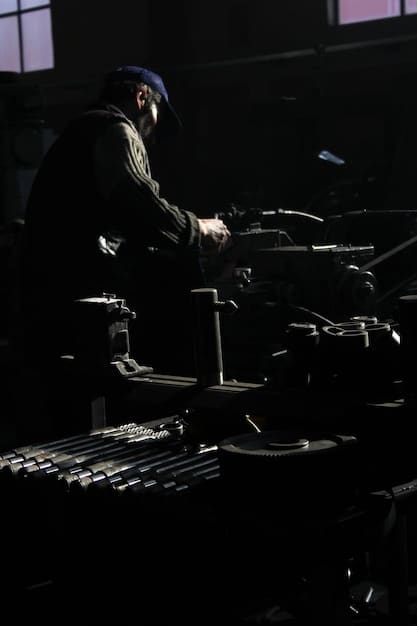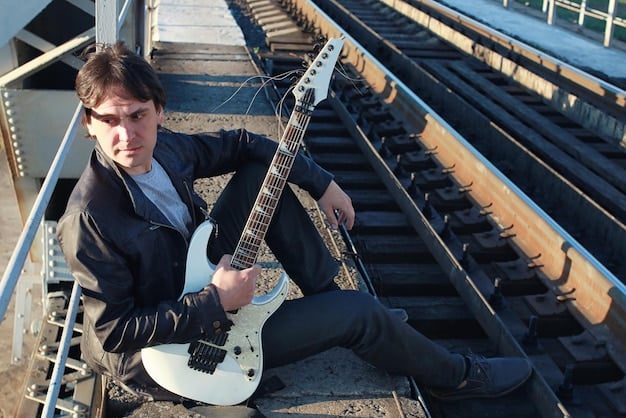Symphonic Metal Orchestration: A Comprehensive Guide

Symphonic metal orchestration intricately blends classical music elements with the power of metal, creating a unique sound characterized by layered instrumentation and dramatic arrangements.
Dive into the realm of symphonic metal orchestration, where the raw energy of metal converges with the grandeur of classical music. Discover how composers intricately weave together soaring melodies, complex harmonies, and powerful rhythms to create an epic and immersive sonic experience.
Understanding the Foundations of Symphonic Metal Orchestration
Symphonic metal orchestration is a complex art that requires understanding of both metal music and classical music principles. It involves more than just adding a few strings or horns; it’s about creating a cohesive and powerful sound that leverages the strengths of both genres. The foundation lies in a deep understanding of orchestration techniques, harmonic structures, and the unique characteristics of metal instrumentation.
Key Elements of Classical Orchestration
Classical orchestration provides the building blocks for creating a lush and dynamic soundscape. Understanding these elements is crucial for successful integration.
- Instrumentation: The strategic use of different instrument families (strings, woodwinds, brass, percussion) to create specific textures and colors.
- Voice Leading: The art of guiding individual instrumental lines to create smooth and coherent harmonies.
- Arrangement: Structuring the musical material for different instruments, considering range, timbre, and dynamic capabilities.
- Dynamic Control: Utilizing changes in volume and intensity to create drama and emotional impact.
These classical elements, when skillfully interwoven with metal elements, elevate the music to a new level of depth and complexity.
The heart of great symphonic metal lies in a very delicate balance. You want strong metal elements, but also those beautiful symphonic parts that emphasize the beauty of the music.
The Role of Keyboards and Synthesizers
Keyboards and synthesizers play a crucial role in symphonic metal orchestration by providing a bridge between the metal instruments and the orchestral sounds. They can emulate the sounds of traditional orchestral instruments, create unique textures, and provide harmonic support.

Emulating Orchestral Instruments
Synthesizers can convincingly replicate the sounds of strings, woodwinds, brass, and even percussion, allowing bands to achieve a full orchestral sound without hiring a full orchestra.
- String Sections: Realistic string samples can create lush and soaring melodies.
- Brass Ensembles: Powerful brass sounds can add weight and majesty to the music.
- Woodwind Textures: Delicate woodwind sounds can create a sense of atmosphere and fragility.
- Unique Soundscapes: Experimenting with synthesizers can result in unique and ear-catching soundscapes.
The possibilities offered by electronic elements open the door to a lot of exciting new creative possibilities.
Keyboards also play an important role in harmonic progression. They add texture and give a musical depth to the music, creating the perfect atmosphere and tone.
Guitar Techniques in Symphonic Metal
Guitars are still a cornerstone of symphonic metal, and proper technique is essential. It is essential to integrate guitars with orchestral elements so they are complementary.
Riffs and Harmonies
The incorporation of guitar riffs alongside orchestral arrangements is a foundational component of symphonic metal.
- Layering Riffs: Guitars often interweave with orchestral parts to create rhythmic complexity.
- Harmonic Integration: Guitar harmonies are often designed to complement the overall orchestral sound.
- Counterpoint: Guitars and orchestral instruments may play counter-melodies against each other.
Understanding the interplay between metal and classical elements offers very compelling creativity.
Guitar parts are often doubled or harmonized to create more powerful riffs and sonic textures, making it a key component in the construction of symphonic parts in metal.

The Importance of Vocal Arrangements
Vocal arrangements are critical in symphonic metal. They dictate the emotional and thematic delivery. It is important that vocals also are well produced and executed.
Classical Vocal Techniques
Symphonic metal vocals draw from diverse traditions, making it one of the most dynamic aspects of the genre.
- Operatic Vocals: Some singers focus on traditional operatic vocal techniques, providing the music with a very grandiose element.
- Choirs and Harmonies: Choirs are often used to create a sense of scale and grandeur.
There are varying degrees of importance when it comes to the vocal portions of symphonic metal, but it is an inescapable element.
Integrating vocals with orchestral elements can create a captivating contrast. This interplay is extremely important in delivering the most powerful and emotionally engaging experience on the listener end.
Balancing Metal and Orchestral Elements
Successfully balancing metal and orchestral elements is the key to creating compelling symphonic metal. It requires a delicate touch and a clear understanding of how the two genres can complement each other. When mixing the elements, try focusing on the parts you want to emphasize.
Dynamic Arrangement
Dynamic arrangements are essential for balancing metal and orchestral elements, shaping the sonic experience decisively.
- Contrast: Alternating between heavy metal sections and soaring orchestral passages.
- Layering: Combining metal and orchestral textures to create a sense of depth and complexity.
Without the delicate dance between orchestral and traditional parts, symphonic is just not symphonic.
Metal is a very strong and direct music form, while orchestral elements can add a sense of drama and intensity, creating something bigger than either on their own.
Case Studies: Notable Symphonic Metal Bands
Looking at successful symphonic metal bands can provide valuable insights into how to effectively integrate classical elements into metal compositions. These bands serve as blueprints for composition.
Nightwish
Nightwish is a pioneer of symphonic metal, known for their lush orchestrations, operatic vocals, and epic songwriting.
Key Features:
- Full Orchestral Arrangements: Nightwish often collaborates with full orchestras to create a truly immersive sound.
- Dynamic Song Structures: Their songs often feature a mix of heavy metal riffs, soaring melodies, and dramatic orchestral passages.
Nightwish uses a lot of operatic and choir vocals to enhance the symphonic elements of its music, as well as more simple instruments like acoustic guitars and pianos.
Examining such successful bands is critical for understanding the balance between metal aggression and orchestral grandeur. It also offers ideas to expand the musical dimensions into new and rewarding spaces.
| Key Point | Brief Description |
|---|---|
| 🎸 Riffs & Harmonies | Guitars interweave with orchestral parts, enhancing metal composition. |
| 🎤 Vocal Arrangements | Classical techniques and choirs add scale and drama to symphonic metal. |
| 🎹 Keyboards/Synths | Emulate instruments for texture, dynamics, and support classical tones. |
| ⚖️ Balancing Metal | Successfully achieving contrast with aggression requires balance. |
Frequently Asked Questions
▼
Symphonic metal orchestration is defined by the integration of classical music elements, such as orchestral arrangements, with the instrumentation and energy of metal music. It combines heavy riffs, complex harmonies, and varied dynamic.
▼
Keyboards in symphonic metal serve multiple purposes, including emulating orchestral instruments, creating unique soundscapes, and providing harmonic support. They add depth and texture, enriching the overall sonic palette with the traditional instruments.
▼
Common vocal styles in symphonic metal include operatic vocals, choirs, and a mix of clean and harsh vocals. Many of these vocal styles are intended to build on the dramatic soundscape that is such a key element.
▼
Balance is achieved through careful arrangements, dynamics, and instrumentation. Symphonic metal typically balances harsh, heavy instrumentation and vocals with soaring melodies and a general beautiful background soundtrack
▼
Notable symphonic metal bands include Nightwish, Epica, Within Temptation, and Therion. This is because their experimentation set the standard for what modern music in the subgenre will sound like.
Conclusion
In conclusion, symphonic metal orchestration is a rich and rewarding area of musical expression that combines the best of metal and classical music. By understanding the principles of both genres and carefully balancing their elements, composers can create truly epic and memorable music.





